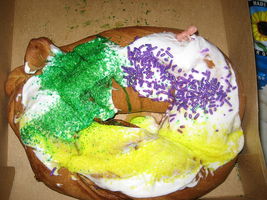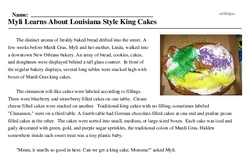Myli Learns About Louisiana Style King Cakes
The distinct aroma of freshly baked bread drifted into the street. A few weeks before Mardi Gras, Myli and her mother, Linda, walked into a downtown New Orleans bakery. An array of bread, cookies, cakes, and doughnuts were displayed behind a tall glass counter. In front of the regular bakery displays, several long tables were stacked high with boxes of Mardi Gras king cakes.
The cinnamon roll-like cakes were labeled according to fillings. There were blueberry and strawberry filled cakes on one table. Cream cheese filled cakes were stacked on another. Traditional king cakes with no filling, sometimes labeled "Cinnamon," were on a third table. A fourth table had German chocolate-filled cakes at one end and praline pecan filled cakes at the other. The cakes were sorted into small, medium, or large sized boxes. Each cake was iced and gaily decorated with green, gold, and purple sugar sprinkles, the traditional colors of Mardi Gras. Hidden somewhere inside each sweet treat was a tiny plastic baby.
"Mmm, it smells so good in here. Can we get a king cake, Momma?" asked Myli.
"That's why we're here. What kind of filling do you like best?"
"Let me see," said Myli as she walked from table to table trying to make up her mind.
"Momma, how did the tradition of king cakes get started in New Orleans?" asked Myli as she was standing in front of the German chocolate filled cakes table.
"King cakes came to New Orleans with the arrival of French colonists. It was part of the French custom to bake a king cake for Epiphany."
"Ih-pip... uh-pif... what?" said Myli.




